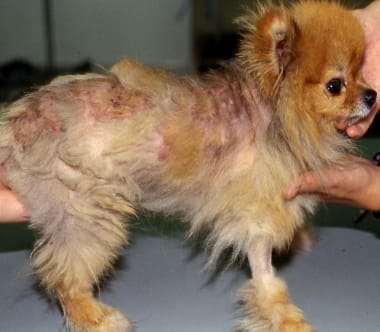Alopecia is the medical term for baldness. A particular type of baldness has been described in the Nordic or double-coated breeds whereby the dog develops symmetrical coat loss on the trunk as well as darkly pigmented skin in the bald areas.
This pattern of baldness is commonly called “endocrine alopecia” as it is common in several types of hormone imbalances (in particular, hypothyroidism.)

Alopecia X goes by many names:The condition we call “alopecia X,” however, is not associated with the hormone imbalances that normally create endocrine alopecia. Its causes remain mysterious hence the name alopecia X.
Given that there are numerous therapies that work for some cases and not for others, and that many of these therapies seem to be in complete opposition, it may be that alopecia X is not one disease but several and we simply do not know how to distinguish them.
- Black skin disease
- Growth hormone-responsive alopecia
- Castration-responsive alopecia
- The coat funk
- Pseudo-Cushing syndrome
- Biopsy-responsive alopecia
- Follicular dysplasia of the Siberian husky
- Adrenal sex hormone alopecia
- Hair cycle arrest
The following is what is currently believed about this confusing condition.
The good news is that alopecia X is a cosmetic condition only. There is no downside to the dog except for looking funny. For this reason, treatment with medications is frequently discouraged because drugs can have bodywide effects while the disease itself has none.
Furthermore, treatment has been fraught with partial responses and can be frustrating if not expensive, depending on what therapy is selected.
The skin biopsy is particularly important in making a diagnosis of alopecia X. If possible, a pathologist who specializes in reading skin tissue should be requested. The biopsy will identify structures typical of alopecia X hair follicles and help rule out concurrent allergy or infection that might mimic alopecia X.
The University of Tennessee Hormone Profile
One option in the pursuit of effective alopecia X therapy is the adrenal sex hormone panel available at the University of Tennessee. This test is done by drawing a baseline blood panel, administering a pituitary hormone called ACTH, and drawing a second blood sample an hour later to compare.
Samples are shipped to Tennessee for evaluation for numerous adrenal sex hormones. The results show not only which hormones respond abnormally but the university will make suggestions as to which therapy might be likely to work.
Testing is not inexpensive and results can take several weeks to obtain but may help in selecting what therapy makes sense to try next. Often, results are ambiguous and difficult to interpret. Different specialists have different opinions on the usefulness of information obtained.
This blood test may be recommended by your veterinarian as part of the alopecia X work up so we mention it here.
The Typical Patient

The typical Alopecia X patient is a Spitz or Nordic breed such as an American Eskimo, Chow Chow, Pomeranian, Alaskan Malamute, Elkhound, or similar. Poodles have also been over-represented. Hair loss begins in early adulthood, usually by age three years.
First the long primary hairs go, leaving a fuzzy, puppy-like coat but eventually that goes, too. The bald skin becomes hyper pigmented but is not itchy, and the skin does not usually get infected.
Diagnostic Testing
Part of the problem is that all hormone-based hair losses can look exactly like this, so some testing is needed to determine which of several conditions are occurring.
Expect your veterinarian to begin with:
- A blood panel
- A urinalysis
- Some kind of thyroid testing
- Some kind of adrenal hormone testing
- A skin biopsy
The purpose of this rather broad testing is to rule out diseases that look like alopecia X but for which well-defined treatment protocols exist. This means that two conditions must absolutely be ruled out before proceeding with the trial and error process of alopecia X treatment.
- Cushing’s disease
- Hypothyroidism
Both these hormone imbalances lead to endocrine alopecia and while they look like alopecia X, they have their own specific treatments.
Therapy
Sterilization
Now that it has been determined that the dog in question has Alopecia X, it would be great if we could wake up the sleeping hair follicles and regrow some hair.
Alopecia X seems to be a sex hormone imbalance in at least some cases and didn’t earn the name castration responsive alopecia for nothing.
For this reason, the first step in treatment is to sterilize the patient; unspayed females should be spayed, intact males should be neutered.
There are health benefits to sterilization regardless of whether or not there is a hair loss issue, and many animals will grow their hair back (though possibly not permanently) so this is where we start rather than investing in complex and confusing diagnostics. If this does not work or the pet is already sterilized, then we move on to melatonin supplementation.
Melatonin
Melatonin can be obtained in 3 mg tablets at most health food stores or vitamin retail outlets. Approximately 50 percent of dogs will show some response within six to eight weeks.
The medication should be given for at least two or three months before giving up but if hair regrowth occurs, the medication is continued until hair growth seems to have plateaued.
After maximal hair regrowth has been achieved, the dose is gradually tapered down to a weekly dose over several months.
Some dogs can ultimately discontinue medication though it is important to realize that if you discontinue the medication and the hair falls out again, the condition may not be responsive to melatonin a second time.
Melatonin Side Effects and Issues
- Melatonin has been used as a sleep aide. Some owners find the sedating side effect to be unacceptable. Consider giving it at bedtime so that drowsiness is less noticeable.
- Melantonin should not be used in diabetic patients as it has been found to create insulin resistance.
- Beware of melatonin brands containing xylitol. Xylitol is an innocuous sugar substitute for people but is a poison for dogs.
Since melatonin is a nutritional supplement, rather than a prescription medication, the FDA does not insist on the same quality control it does for drugs.
There may be tremendous differences in the amount of melatonin contained in pills between brands. Nature’s Bounty® brand has been a preferred brand but any major supplement brand should be acceptable.
If neither sterilization nor melatonin have been fruitful and we know the dog does not have Cushing’s disease or hypothyroidism, then it is important to realize that the therapies left to try have potential side effects.
Consider this: Alopecia X is a cosmetic condition. It may make the dog look funny, but it does not cause harm.
You will need to weigh the potential side effects of therapy against your pet’s appearance. That said, there are other therapies that can be attempted.
Micro Needling
Alopecia X is sometimes called biopsy responsive alopecia. After the skin biopsy samples are taken in the diagnostic process described above, some dogs will regrow their hair in the small biopsy areas.
The theory is that the inflammation associated with healing has awakened the hair follicles in that local area. This concept is applied more broadly with micro needling, in which a roller of tiny needles is rolled over the skin creating tiny punctures and putting the skin into a healing mode.
This procedure is widely used in human aesthetics to generate collagen, remove wrinkles and brighten skin complexion. The needles can be painful so the patient must be anesthetized or numbed with topical anesthetics.
The skin is somewhat tender for a day or so after the procedure. Different studies report different success rates ranging from 40 to 90 percent. Because some discomfort is afforded the patient and sedation is typically needed, plus alopecia X is of cosmetic concern only, using this treatment is somewhat controversial.
Deslorelin Implants
Deslorelin is a veterinary hormone that curtails the production of estrogen and testosterone, and is usually used to time ovulation in mares. It is available as an implant and was recently tested in alopecia X.
Within three months, 60 percent of the unneutered male dogs experienced hair regrowth. None of the spayed females experienced hair regrowth. No side effects were noted during the one year period of testing. This may pan out as a treatment strategy for unneutered male dogs.
Alopecia X is a frustrating condition and will likely remain so for years to come. Research is on-going and progress comes gradually.


